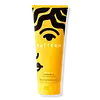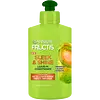What's inside
What's inside
 Key Ingredients
Key Ingredients

 Benefits
Benefits

 Concerns
Concerns

 Ingredients Side-by-side
Ingredients Side-by-side

Water
Skin ConditioningCetearyl Alcohol
EmollientBehentrimonium Methosulfate
Caprylic/Capric Triglyceride
MaskingButylene Glycol
HumectantBiotin
AntiseborrhoeicPanthenol
Skin ConditioningSimmondsia Chinensis Seed Oil
EmollientRicinus Communis Seed Oil
MaskingPersea Gratissima Oil
Skin ConditioningOlea Europaea Fruit Oil
MaskingMelaleuca Alternifolia Leaf Oil
AntioxidantMel
EmollientCocos Nucifera Oil
MaskingArgania Spinosa Kernel Oil
EmollientPrunus Amygdalus Dulcis Oil
Skin ConditioningButyrospermum Parkii Oil
EmollientHydrolyzed Vegetable Protein Pg-Propyl Silanetriol
Skin ConditioningAloe Barbadensis Leaf Extract
EmollientTocopherol
AntioxidantPolyquaternium-37
Propylene Glycol Dicaprylate/Dicaprate
EmollientEthylhexylglycerin
Skin ConditioningTrideceth-3
EmulsifyingTrideceth-15
EmulsifyingCetrimonium Chloride
AntimicrobialAmodimethicone
Parfum
MaskingPPG-1 Trideceth-6
Skin ConditioningGlycerin
HumectantAminomethyl Propanol
BufferingPhenoxyethanol
PreservativeCitric Acid
BufferingAlcohol
AntimicrobialAcetic Acid
BufferingPotassium Sorbate
PreservativeDisodium EDTA
Linalool
PerfumingAmyl Cinnamal
PerfumingButylphenyl Methylpropional
PerfumingBenzyl Benzoate
AntimicrobialHydroxycitronellal
PerfumingCitronellol
PerfumingCoumarin
PerfumingLimonene
PerfumingHexyl Cinnamal
PerfumingWater, Cetearyl Alcohol, Behentrimonium Methosulfate, Caprylic/Capric Triglyceride, Butylene Glycol, Biotin, Panthenol, Simmondsia Chinensis Seed Oil, Ricinus Communis Seed Oil, Persea Gratissima Oil, Olea Europaea Fruit Oil, Melaleuca Alternifolia Leaf Oil, Mel, Cocos Nucifera Oil, Argania Spinosa Kernel Oil, Prunus Amygdalus Dulcis Oil, Butyrospermum Parkii Oil, Hydrolyzed Vegetable Protein Pg-Propyl Silanetriol, Aloe Barbadensis Leaf Extract, Tocopherol, Polyquaternium-37, Propylene Glycol Dicaprylate/Dicaprate, Ethylhexylglycerin, Trideceth-3, Trideceth-15, Cetrimonium Chloride, Amodimethicone, Parfum, PPG-1 Trideceth-6, Glycerin, Aminomethyl Propanol, Phenoxyethanol, Citric Acid, Alcohol, Acetic Acid, Potassium Sorbate, Disodium EDTA, Linalool, Amyl Cinnamal, Butylphenyl Methylpropional, Benzyl Benzoate, Hydroxycitronellal, Citronellol, Coumarin, Limonene, Hexyl Cinnamal
Water
Skin ConditioningCetearyl Alcohol
EmollientAmodimethicone
Cetyl Esters
EmollientBehentrimonium Chloride
PreservativeParfum
MaskingPyrus Malus Fruit Extract
Skin ConditioningIsopropyl Alcohol
SolventTrideceth-6
EmulsifyingArgania Spinosa Kernel Oil
EmollientNiacinamide
SmoothingPyridoxine Hcl
Skin ConditioningHexyl Cinnamal
PerfumingChlorhexidine Dihydrochloride
AntimicrobialCitric Acid
BufferingCetrimonium Chloride
AntimicrobialSaccharum Officinarum Extract
MoisturisingBenzyl Alcohol
PerfumingLinalool
PerfumingAmyl Cinnamal
PerfumingTocopherol
AntioxidantHydroxypropyltrimonium Lemon Protein
HumectantCI 19140
Cosmetic ColorantCI 15985
Cosmetic ColorantPhenoxyethanol
PreservativeCitrus Limon Peel Extract
EmollientLeuconostoc/Radish Root Ferment Filtrate
AntimicrobialCamellia Sinensis Leaf Extract
AntimicrobialWater, Cetearyl Alcohol, Amodimethicone, Cetyl Esters, Behentrimonium Chloride, Parfum, Pyrus Malus Fruit Extract, Isopropyl Alcohol, Trideceth-6, Argania Spinosa Kernel Oil, Niacinamide, Pyridoxine Hcl, Hexyl Cinnamal, Chlorhexidine Dihydrochloride, Citric Acid, Cetrimonium Chloride, Saccharum Officinarum Extract, Benzyl Alcohol, Linalool, Amyl Cinnamal, Tocopherol, Hydroxypropyltrimonium Lemon Protein, CI 19140, CI 15985, Phenoxyethanol, Citrus Limon Peel Extract, Leuconostoc/Radish Root Ferment Filtrate, Camellia Sinensis Leaf Extract
Ingredients Explained
These ingredients are found in both products.
Ingredients higher up in an ingredient list are typically present in a larger amount.
This water-soluble silicone is used for its hydrating and softening properties. It is used to add a silky feel to skincare products and has great benefits for haircare.
In haircare, this ingredient:
- Adds shine
- Protects color
- Offers thermal protection
- Boosts hair strength
- Does not build up as easily
Amyl Cinnamal is a synthetically produced fragrance. Its scent is reminiscent of jasmine flowers.
Amyl Cinnamal is a known EU allergen. This means it is known to cause skin sensitivity and allergies.
You may know this ingredient as argan oil. Argan Oil has antioxidant, hydrating, and soothing properties.
Studies have shown argan oil can help fight again radical damage from the sun. This makes it effective at preventing hyperpigmentation.
Large amounts of vitamin E found in argan oil helps the skin retain water. Argan oil also contains fatty acids such as linoleic acid, oleic acid, and palmitic acid. It is also a good source of lipids.
Another benefit of argan oil is skin-soothing. It can help reduce inflammation-related skin symptoms.
Argan Oil is effective at regulating sebum production in pores. This can make it effective at treating hormonal acne.
Traditionally, argan oil was used for its antibacterial and antifungal properties. However, argan oil contains fatty acids that may make it not fungal-acne safe.
Argan Trees are native to Morocco.
Learn more about Argania Spinosa Kernel OilCetearyl alcohol is a mixture of two fatty alcohols: cetyl alcohol and stearyl alcohol. It is mainly used as an emulsifier. Emulsifiers help prevent the separation of oils and products. Due to its composition, it can also be used to thicken a product or help create foam.
Cetearyl alcohol is an emollient. Emollients help soothe and hydrate the skin by trapping moisture.
Studies show Cetearyl alcohol is non-toxic and non-irritating. The FDA allows products labeled "alcohol-free" to have fatty alcohols.
This ingredient is usually derived from plant oils such as palm, vegetable, or coconut oils. There is debate on whether this ingredient will cause acne.
Due to the fatty acid base, this ingredient may not be Malassezia folliculitis safe.
Learn more about Cetearyl AlcoholThis ingredient is a preservative, antimicrobial, and emulsifier. It is often used in cosmetics for its ability to cleanse, condition, and reduce static.
Cetrimonium chloride is a quaternary ammonium salt, meaning it has a water-soluble structure.
Citric Acid is an alpha hydroxy acid (AHA) naturally found in citrus fruits like oranges, lemons, and limes.
Like other AHAs, citric acid can exfoliate skin by breaking down the bonds that hold dead skin cells together. This helps reveal smoother and brighter skin underneath.
However, this exfoliating effect only happens at high concentrations (20%) which can be hard to find in cosmetic products.
Due to this, citric acid is usually included in small amounts as a pH adjuster. This helps keep products slightly more acidic and compatible with skin's natural pH.
In skincare formulas, citric acid can:
While it can provide some skin benefits, research shows lactic acid and glycolic acid are generally more effective and less irritating exfoliants.
Most citric acid used in skincare today is made by fermenting sugars (usually from molasses). This synthetic version is identical to the natural citrus form but easier to stabilize and use in formulations.
Read more about some other popular AHA's here:
Learn more about Citric AcidHexyl Cinnamal is a fragrance ingredient with a similar scent to jasmine. It can be naturally found in chamomile essential oil.
This ingredient is a known EU allergen and may sensitize the skin. The EU requires this ingredient to be listed separately on an ingredients list.
Hexyl Cinnamal is not water soluble but is soluble in oils.
Learn more about Hexyl CinnamalLinalool is a fragrance and helps add scent to products. It's derived from common plants such as cinnamon, mint, citrus, and lavender.
Like Limonene, this ingredient oxidizes when exposed to air. Oxidized linalool can cause allergies and skin sensitivity.
This ingredient has a scent that is floral, spicy tropical, and citrus-like.
Learn more about LinaloolParfum is a catch-all term for an ingredient or more that is used to give a scent to products.
Also called "fragrance", this ingredient can be a blend of hundreds of chemicals or plant oils. This means every product with "fragrance" or "parfum" in the ingredients list is a different mixture.
For instance, Habanolide is a proprietary trade name for a specific aroma chemical. When used as a fragrance ingredient in cosmetics, most aroma chemicals fall under the broad labeling category of “FRAGRANCE” or “PARFUM” according to EU and US regulations.
The term 'parfum' or 'fragrance' is not regulated in many countries. In many cases, it is up to the brand to define this term.
For instance, many brands choose to label themselves as "fragrance-free" because they are not using synthetic fragrances. However, their products may still contain ingredients such as essential oils that are considered a fragrance by INCI standards.
One example is Calendula flower extract. Calendula is an essential oil that still imparts a scent or 'fragrance'.
Depending on the blend, the ingredients in the mixture can cause allergies and sensitivities on the skin. Some ingredients that are known EU allergens include linalool and citronellol.
Parfum can also be used to mask or cover an unpleasant scent.
The bottom line is: not all fragrances/parfum/ingredients are created equally. If you are worried about fragrances, we recommend taking a closer look at an ingredient. And of course, we always recommend speaking with a professional.
Learn more about ParfumPhenoxyethanol is a preservative that has germicide, antimicrobial, and aromatic properties. Studies show that phenoxyethanol can prevent microbial growth. By itself, it has a scent that is similar to that of a rose.
It's often used in formulations along with Caprylyl Glycol to preserve the shelf life of products.
Tocopherol (also known as Vitamin E) is a common antioxidant used to help protect the skin from free-radicals and strengthen the skin barrier. It's also fat soluble - this means our skin is great at absorbing it.
Vitamin E also helps keep your natural skin lipids healthy. Your lipid skin barrier naturally consists of lipids, ceramides, and fatty acids. Vitamin E offers extra protection for your skin’s lipid barrier, keeping your skin healthy and nourished.
Another benefit is a bit of UV protection. Vitamin E helps reduce the damage caused by UVB rays. (It should not replace your sunscreen). Combining it with Vitamin C can decrease sunburned cells and hyperpigmentation after UV exposure.
You might have noticed Vitamin E + C often paired together. This is because it is great at stabilizing Vitamin C. Using the two together helps increase the effectiveness of both ingredients.
There are often claims that Vitamin E can reduce/prevent scarring, but these claims haven't been confirmed by scientific research.
Learn more about TocopherolWater. It's the most common cosmetic ingredient of all. You'll usually see it at the top of ingredient lists, meaning that it makes up the largest part of the product.
So why is it so popular? Water most often acts as a solvent - this means that it helps dissolve other ingredients into the formulation.
You'll also recognize water as that liquid we all need to stay alive. If you see this, drink a glass of water. Stay hydrated!
Learn more about Water